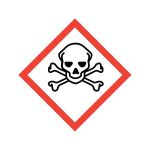

Sodium selenite (Na₂SeO₃) is an inorganic compound recognized for its colorless solid form. The pink-colored pentahydrate, Na₂SeO₃·5H₂O, is the most common water-soluble selenium compound. It is synthesised by the reaction of selenium dioxide with sodium hydroxide. It is the most common selenium supplement for pet foods approved by the U.S. Food and Drug Administration.

CAS No.: 10102-18-8
Synonyms: Disodium selenite; Selenious acid disodium salt; Natriumselenit; Sodium biselenite; Selenite, sodium; Pleo selene; Sodium selenite anhydrous; Disodium selenium trioxide.
| Physical Properties | |
| Chemical formula | Na2SeO3 |
| IUPAC Name | Disodium selenite |
| Molecular weight | 172.95 g/mol |
| Density | 3.1 g/cm³ |
| Solubility | Water, methanol & ethanol |
| Chemical Properties | |
| Color | White to Off-white |
| State | Solid Crystalline Powder |
| Melting point | 710 °C |
| λmax | 205.1 nm |
| pKa | 1.2 |
| LogP | -1.3 |
| Pictograms : |   |
| Hazard Statements : | H300 + H330: Fatal if swallowed or if inhaled. |
| Precautionary statements : | P260: Do not breathe dust. P273: Avoid release to the environment. P280: Wear protective gloves/ eye protection/ face protection. P302 + P352: IF ON SKIN: Wash with plenty of water. P304 + P340 + P310: IF INHALED: Remove person to fresh air and keep comfortable for breathing. Immediately call a POISON CENTER/ doctor. P305 + P351 + P338: IF IN EYES: Rinse cautiously with water for several minutes. Remove contact lenses, if present, and easy to do. Continue rinsing. |
Sodium selenite (Na₂SeO₃) is an inorganic compound recognized for its colorless solid form. The pink-colored pentahydrate, Na₂SeO₃·5H₂O, is the most common water-soluble selenium compound. It is synthesised by the reaction of selenium dioxide with sodium hydroxide. It is the most common selenium supplement for pet foods approved by the U.S. Food and Drug Administration.

CAS No.: 10102-18-8
Synonyms: Disodium selenite; Selenious acid disodium salt; Natriumselenit; Sodium biselenite; Selenite, sodium; Pleo selene; Sodium selenite anhydrous; Disodium selenium trioxide.
| Physical Properties | |
| Chemical formula | Na2SeO3 |
| IUPAC Name | Disodium selenite |
| Molecular weight | 172.95 g/mol |
| Density | 3.1 g/cm³ |
| Solubility | Water, methanol & ethanol |
| Chemical Properties | |
| Color | White to Off-white |
| State | Solid Crystalline Powder |
| Melting point | 710 °C |
| λmax | 205.1 nm |
| pKa | 1.2 |
| LogP | -1.3 |
| Pictograms : |   |
| Hazard Statements : | H300 + H330: Fatal if swallowed or if inhaled. |
| Precautionary statements : | P260: Do not breathe dust. P273: Avoid release to the environment. P280: Wear protective gloves/ eye protection/ face protection. P302 + P352: IF ON SKIN: Wash with plenty of water. P304 + P340 + P310: IF INHALED: Remove person to fresh air and keep comfortable for breathing. Immediately call a POISON CENTER/ doctor. P305 + P351 + P338: IF IN EYES: Rinse cautiously with water for several minutes. Remove contact lenses, if present, and easy to do. Continue rinsing. |
Sodium selenite is used as a supplement to provide selenium in animal feeds and dietary supplements. It is utilized in the manufacturing of colorless glass and other applications involving selenium chemistry.
Selenium is a trace mineral essential for health, while sodium selenite is a compound that contains selenium. Sodium selenite is a form of selenium used in supplements and animal feeds.
Sodium selenite is not inherently toxic at recommended levels but can become harmful in excess. Proper dosage control is crucial to prevent toxicity.
Sodium selenite is employed in veterinary medicine as a supplement to prevent selenium deficiency in animals. It helps support proper growth, immune function, and reproduction in livestock and pets.
Sodium selenite is synthetic. It is an inorganic compound typically produced through chemical processes involving selenium and sodium hydroxide.
Sodium selenite provides essential selenium, supporting antioxidant activity, thyroid function, and immune health. It’s used in supplements to direct selenium deficiency in humans and animals.
Sodium selenite is added to cat and dog food as a source of selenium, an essential trace mineral that supports immune function and thyroid health.
It prevents hair loss by strengthening hair follicles and supporting healthy thyroid function, which affects hair growth. Its antioxidant property helps in neutralizing free radicals that can damage hair follicles.